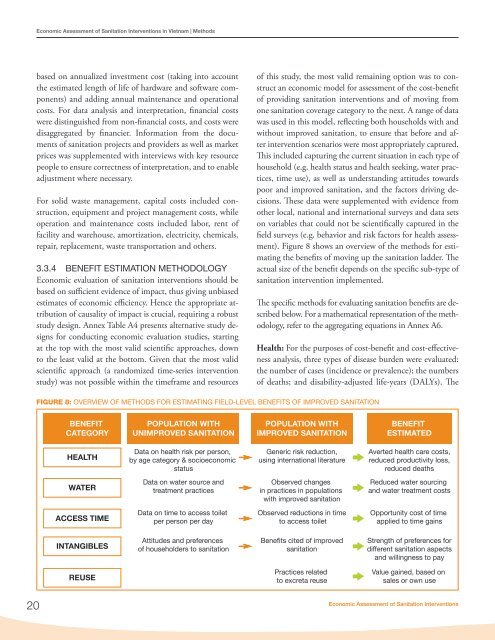Economic Assessment of Sanitation Interventions in Vietnam - WSP
Economic Assessment of Sanitation Interventions in Vietnam - WSP
Economic Assessment of Sanitation Interventions in Vietnam - WSP
Create successful ePaper yourself
Turn your PDF publications into a flip-book with our unique Google optimized e-Paper software.
<strong>Economic</strong> <strong>Assessment</strong> <strong>of</strong> <strong>Sanitation</strong> <strong>Interventions</strong> <strong>in</strong> <strong>Vietnam</strong> | Methodsbased on annualized <strong>in</strong>vestment cost (tak<strong>in</strong>g <strong>in</strong>to accountthe estimated length <strong>of</strong> life <strong>of</strong> hardware and s<strong>of</strong>tware components)and add<strong>in</strong>g annual ma<strong>in</strong>tenance and operationalcosts. For data analysis and <strong>in</strong>terpretation, f<strong>in</strong>ancial costswere dist<strong>in</strong>guished from non-f<strong>in</strong>ancial costs, and costs weredisaggregated by f<strong>in</strong>ancier. Information from the documents<strong>of</strong> sanitation projects and providers as well as marketprices was supplemented with <strong>in</strong>terviews with key resourcepeople to ensure correctness <strong>of</strong> <strong>in</strong>terpretation, and to enableadjustment where necessary.For solid waste management, capital costs <strong>in</strong>cluded construction,equipment and project management costs, whileoperation and ma<strong>in</strong>tenance costs <strong>in</strong>cluded labor, rent <strong>of</strong>facility and warehouse, amortization, electricity, chemicals,repair, replacement, waste transportation and others.3.3.4 BENEFIT ESTIMATION METHODOLOGY<strong>Economic</strong> evaluation <strong>of</strong> sanitation <strong>in</strong>terventions should bebased on sufficient evidence <strong>of</strong> impact, thus giv<strong>in</strong>g unbiasedestimates <strong>of</strong> economic efficiency. Hence the appropriate attribution<strong>of</strong> causality <strong>of</strong> impact is crucial, requir<strong>in</strong>g a robuststudy design. Annex Table A4 presents alternative study designsfor conduct<strong>in</strong>g economic evaluation studies, start<strong>in</strong>gat the top with the most valid scientific approaches, downto the least valid at the bottom. Given that the most validscientific approach (a randomized time-series <strong>in</strong>terventionstudy) was not possible with<strong>in</strong> the timeframe and resources<strong>of</strong> this study, the most valid rema<strong>in</strong><strong>in</strong>g option was to constructan economic model for assessment <strong>of</strong> the cost-benefit<strong>of</strong> provid<strong>in</strong>g sanitation <strong>in</strong>terventions and <strong>of</strong> mov<strong>in</strong>g fromone sanitation coverage category to the next. A range <strong>of</strong> datawas used <strong>in</strong> this model, reflect<strong>in</strong>g both households with andwithout improved sanitation, to ensure that before and after<strong>in</strong>tervention scenarios were most appropriately captured.This <strong>in</strong>cluded captur<strong>in</strong>g the current situation <strong>in</strong> each type <strong>of</strong>household (e.g. health status and health seek<strong>in</strong>g, water practices,time use), as well as understand<strong>in</strong>g attitudes towardspoor and improved sanitation, and the factors driv<strong>in</strong>g decisions.These data were supplemented with evidence fromother local, national and <strong>in</strong>ternational surveys and data setson variables that could not be scientifically captured <strong>in</strong> thefield surveys (e.g. behavior and risk factors for health assessment).Figure 8 shows an overview <strong>of</strong> the methods for estimat<strong>in</strong>gthe benefits <strong>of</strong> mov<strong>in</strong>g up the sanitation ladder. Theactual size <strong>of</strong> the benefit depends on the specific sub-type <strong>of</strong>sanitation <strong>in</strong>tervention implemented.The specific methods for evaluat<strong>in</strong>g sanitation benefits are describedbelow. For a mathematical representation <strong>of</strong> the methodology,refer to the aggregat<strong>in</strong>g equations <strong>in</strong> Annex A6.Health: For the purposes <strong>of</strong> cost-benefit and cost-effectivenessanalysis, three types <strong>of</strong> disease burden were evaluated:the number <strong>of</strong> cases (<strong>in</strong>cidence or prevalence); the numbers<strong>of</strong> deaths; and disability-adjusted life-years (DALYs). TheFIGURE 8: OVERVIEW OF METHODS FOR ESTIMATING FIELD-LEVEL BENEFITS OF IMPROVED SANITATIONBENEFITCATEGORYPOPULATION WITHUNIMPROVED SANITATIONPOPULATION WITHIMPROVED SANITATIONBENEFITESTIMATEDHEALTHData on health risk per person,by age category & socioeconomicstatusGeneric risk reduction,us<strong>in</strong>g <strong>in</strong>ternational literatureAverted health care costs,reduced productivity loss,reduced deathsWATERData on water source andtreatment practicesObserved changes<strong>in</strong> practices <strong>in</strong> populationswith improved sanitationReduced water sourc<strong>in</strong>gand water treatment costsACCESS TIMEData on time to access toiletper person per dayObserved reductions <strong>in</strong> timeto access toiletOpportunity cost <strong>of</strong> timeapplied to time ga<strong>in</strong>sINTANGIBLESAttitudes and preferences<strong>of</strong> householders to sanitationBenefits cited <strong>of</strong> improvedsanitationStrength <strong>of</strong> preferences fordifferent sanitation aspectsand will<strong>in</strong>gness to payREUSEPractices relatedto excreta reuseValue ga<strong>in</strong>ed, based onsales or own use20<strong>Economic</strong> <strong>Assessment</strong> <strong>of</strong> <strong>Sanitation</strong> <strong>Interventions</strong>
















